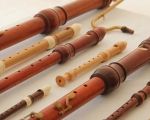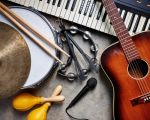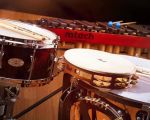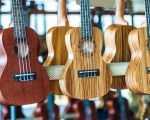Building Your Perfect Small Home Studio: The Essential Gear You Need
When I first decided to build my own home studio, I faced a common dilemma that many aspiring musicians or producers encounter: how to create a functional, professional-grade setup without breaking the bank. My small space limited me in terms of budget and available room, but I knew with the right music equipment, I could still create a studio that delivers high-quality sound. In this article, I’ll share my journey and give you a guide to the best music equipment for small home studios, from affordable audio interfaces to high-end microphones.
1. Audio Interface: The Heart of Your Home Studio
When it comes to recording and producing music at home, an audio interface is a must-have piece of equipment. This device allows you to connect your instruments, microphones, and other gear to your computer or recording software. I remember the first time I used an audio interface—everything just clicked. My recordings sounded cleaner and more professional than when I was using my laptop’s built-in sound card.
For small studios, you don’t need to buy the most expensive interface. I recommend looking into brands like Focusrite, PreSonus, and Behringer. The Focusrite Scarlett 2i2, for instance, is a great choice for beginners. It’s affordable, easy to use, and delivers excellent sound quality. If you’re working with a larger setup or need more inputs, consider the PreSonus Studio 24c. It offers multiple input options and high-resolution audio without the hefty price tag.
2. Studio Monitors: Hear Every Detail
Next up on the list of essential equipment for any home studio are studio monitors. These are specialized speakers designed to provide accurate sound reproduction, which is crucial when mixing and mastering your tracks. I remember spending hours mixing a track on regular speakers, only to find that the final result sounded completely different on a higher-end system. The problem? My old speakers weren’t giving me an honest representation of the sound.
For small spaces, look for compact studio monitors that still pack a punch. The KRK Rokit 5 G4 or Yamaha HS5 are great options. Both deliver clear, balanced sound with tight bass and crisp highs. Remember, your monitor setup can make or break your mix, so investing in good speakers will pay off in the long run.
3. Microphone: Capture Your Sound with Precision
If you plan on recording vocals or acoustic instruments, a high-quality microphone is essential. Initially, I didn’t realize how much of a difference a good mic could make. I used to record vocals on a cheap mic, and it always sounded muffled or tinny. That all changed when I upgraded to a condenser microphone, which captures sound more accurately and with better detail.
The Audio-Technica AT2020 is a fantastic budget option that works well in a home studio. It’s a cardioid condenser microphone, which means it focuses on sound coming from the front while minimizing noise from the sides and rear. If you’re looking to take your recordings to the next level, the Shure SM7B is another top choice, especially for vocals, offering a rich, smooth tone.
4. Acoustic Treatment: A Game-Changer for Small Spaces
In my small home studio, I quickly realized that even with great equipment, the sound quality was lacking due to the acoustics of the room. The walls reflected too much sound, creating a muddy mix. That’s when I learned the importance of acoustic treatment. It doesn’t matter how high-end your gear is if your room is full of echo and bad reflections.
Investing in some basic acoustic treatment like foam panels, bass traps, and diffusers can dramatically improve the sound of your recordings. I started with some budget-friendly foam panels from Auralex and placed them at the reflection points in my room. This small change made a huge difference in the clarity of my sound. If you have a tight budget, DIY treatments, like using heavy curtains or carpets, can also help minimize unwanted noise.
5. MIDI Controller: Add Versatility to Your Setup
For anyone involved in electronic music production, a MIDI controller is a fantastic tool. It allows you to control virtual instruments and software synthesizers in a hands-on way, adding a personal touch to your creations. I remember being skeptical about using a MIDI controller at first, but once I started incorporating it into my workflow, it became an indispensable part of my setup.
The Akai MPK Mini is a perfect MIDI controller for small home studios due to its compact size and affordable price. It features velocity-sensitive pads, knobs, and keys, making it a versatile choice for both beginners and advanced producers. If you’re looking for something with a bit more functionality, the Novation Launchkey 25 offers excellent integration with software like Ableton Live and other DAWs.
6. Headphones: Precise Monitoring for Every Detail
When recording or mixing in a small home studio, you’ll likely spend a significant amount of time wearing headphones. I initially relied on cheap earbuds for my mixing sessions, and it didn’t take long to realize that I wasn’t hearing the full picture. Investing in a pair of studio headphones is essential for detailed monitoring.
One of the best headphones I’ve used is the Audio-Technica ATH-M50X. These headphones are comfortable, offer great isolation, and provide a well-balanced sound that’s perfect for mixing. Another great choice for budget-conscious musicians is the Sony MDR-7506, which has been a staple in professional studios for years.
7. DAW (Digital Audio Workstation): Your Creative Hub
Of course, no home studio setup would be complete without a DAW (Digital Audio Workstation). This is where all the magic happens. It’s the software that allows you to record, edit, and produce your music. When I first started out, I used free DAWs like Audacity, but as my skills grew, I upgraded to something more powerful.
Popular DAWs like Ableton Live, Logic Pro X, and FL Studio are all fantastic options for musicians and producers. I personally use Ableton Live for its intuitive interface and versatility in electronic music production, but all of these DAWs are highly regarded in the industry. If you’re just getting started, try the free version of Reaper or GarageBand to test the waters before committing to a paid DAW.
8. Cables and Accessories: Don’t Overlook the Small Stuff
Lastly, the often-overlooked cables and accessories are crucial in setting up your home studio. Trust me, I learned this the hard way when I was struggling with signal loss and bad connections. Make sure you have good-quality cables for your microphone, speakers, and instruments. A few essential accessories include mic stands, pop filters for vocals, and a comfortable chair for long sessions.
While it may seem like small details, these items will help you work efficiently and comfortably in your studio. A pop filter, for example, helps eliminate popping sounds from vocal recordings, improving the clarity of your vocals. A mic stand will ensure that your microphone stays in place while recording, saving you from awkward setups and distractions.








